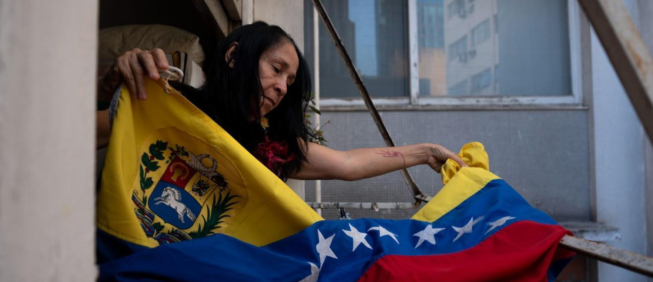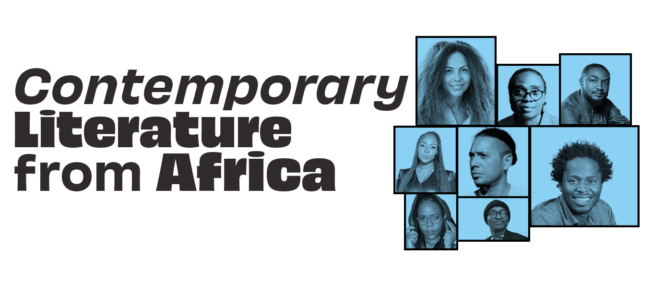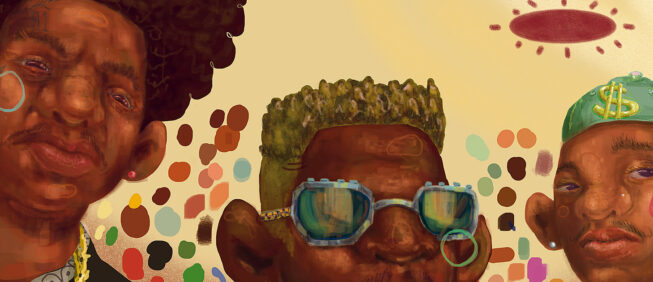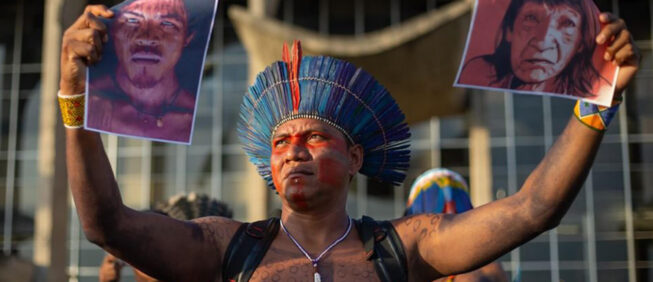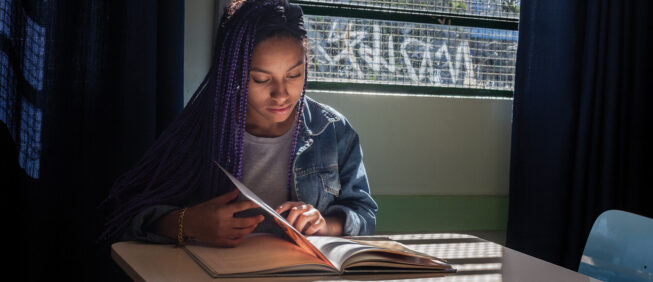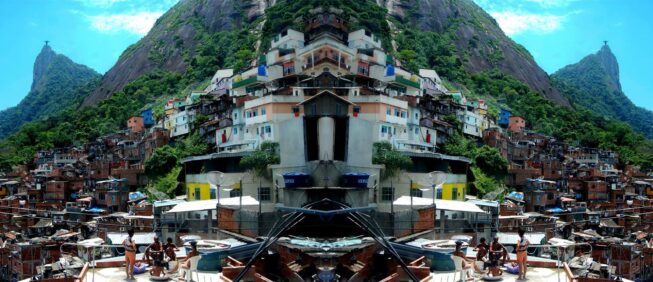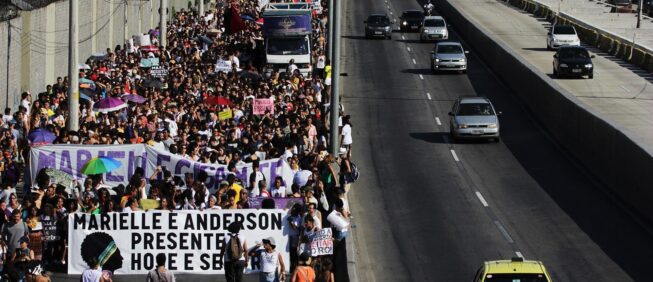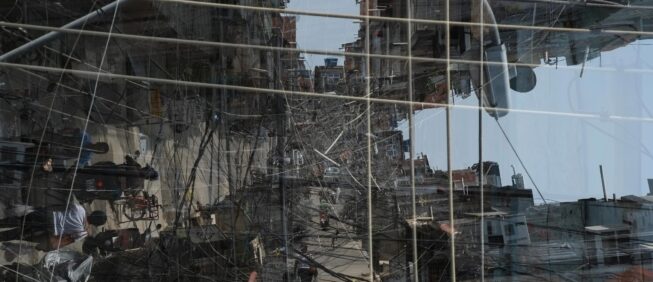Theatre as a strategy for social change
Colonialism and apartheid operated with segregated prisons, in the country where multicultural and multilingual traditions created a national culture of theater. In prisons, they also highlight the public health crisis of HIV/AIDS
Ashley Lucas | Vicente Concílio
| USA | South Africa | Brazil |
December, 2022
introduction
by Vicente Concílio
Can discussions of mass incarceration and the challenges of producing art in punitive environments generate reflections that extrapolate the simple description of what happened and the challenges we face? This challenge was accepted by the teacher Ashley Lucas, from the University of Michigan, in her book Theaters in Prisons and the Global Crisis of Incarceration, published in 2021 by the publisher Hucitec.
I met Ashley Lucas at a seminar about art and culture in prisons, in August of 2015, hosted by the teachers Viviane Becker Narvaes and Natália Ribeiro Fiche. Both teachers are from the theater course in Unirio and they manage an extension course that has been running for 25 years, which promotes artistic workshops in prisons in Rio de Janeiro and, more recently, they have organized protests with survivors of the system. The project is called “Culture in Prisons”, and it took place across four prisons in Rio de Janeiro.
At that time, Ashley was already bringing, for the third consecutive year, a group of students from the University of Michigan to learn about, for three weeks, extension actions developed by Unirio professors in a variety of contexts: in addition to events in prisons, they could visit and participate in the activities of Teatro Renascer, coordinated by Professor Carmela Soares, a theater group for elderly people that took place at the University Hospital Gaffrée and Guinle; The Hospital as a Scenic Universe, by Professor Miguel Vellinho, which took place at Hospital da Lagoa and the Community Theater Program, by Professor Marina Henriques Coutinho, which offers theater workshops at three different places in the Maré Favelas and in the city's North Zone: at the CAM – Art Center of Maré , the Dicró Arena (located at Penha) and the Américo Veloso Municipal Health Center (located at Ramos).
The group that accompanied Ashley Lucas on her visits to Brazil was made up of students who had participated in her course “Theater and Imprisonment”, offered to all students at the University of Michigan, who would act as teachers of visual arts, music, creative writing or theater in a Michigan state penal unit. In short, it was a diverse group (there were students in the healthcare field, psychologists, even historians and economists, and artists, of course) that was multi-ethnic and knowledgeable about the social issues in the USA and in Brazil.
I got along with Ashley pretty much instantly and during that time, she became interested in my research, which I had done in São Paulo, in the beginning of the 2000s. I tried to compile a historical account of theatrical programs in prisons in São Paulo, and I also wrote about my experience as a theater teacher in prisons.
Ashley was doing the research that resulted in the book Theater in Prisons and the Global Crisis of Incarceration, which has been published in Portuguese through a translations project coordinated by me. It was wonderful to have had this opportunity, and even better to have found a publisher for the book.
This is an important book not only for those who practice and propose theatrical workshops in prisons, but for all people who work with the issue of imprisonment and seek, on a daily basis, arguments to demolish the punitive logic that structures and underpins the retrograde, militaristic and armaments discourses that are strongly imposed on common sense.
Reporting and analyzing theatrical practices that Ashley experienced in prison units in ten different countries (Brazil, United States, Uruguay, Canada, South Africa, United Kingdom, Ireland, Australia, New Zealand and Portugal), the book also finds its strength in the reports of travel and the memories she shares with us, as the daughter of a father who suffered two decades of imprisonment. The fourth edition of the book has a foreword written by Juliana Borges, a key researcher in the area of imprisonment in our country. She writes:
"Theater in prison provides the repositioning of incarcerated people, either through other ways of exercising freedom, or through breaking up, even during rehearsal and presentation hours, with the violent dynamics of prison. (...) Lucas demonstrates that the fact that theater is a space for collaboration, respect, sharing and engagement makes it a possibility for individuals in prison to reinvent themselves, whether that’s about themselves or about the relationships they establish with their group, community and family."
What the excerpt highlights is that the meanings of the scenes that take place behind bars escape utilitarian and instantaneous definitions, because they speak of a true reinvention of individuals as a collective.
The excerpt from the book that we bring here is part of the third chapter of the book, in which Ashley introduces us to the realities of prison in South Africa, while lending us her sensitive lens to expose the specificities of prison in that country: the legacy of unjust political prisons from the apartheid era, which deprived leaders who fought for racial equity from their freedom, and the context of the HIV/AIDS epidemic, which mobilizes and contextualizes many of the actions involving theatrical projects in that country.
When my collaborator Andy Martínez and I traveled to South Africa for the first time in 2014, the nation was celebrating twenty years since the fall of apartheid in 1994. Tee shirts and banners in the streets of Johannesburg proclaimed “twenty years of democracy.” Yet, as we moved from place to place, we saw how legacies of colonialism, segregation, and brutal oppression remain apparent in South Africa today, as they do in my own country. And as in my country—in any country—the divides created by this history are nowhere more apparent than inside prisons.
During apartheid and in the present, blacks and mixed-race people were and are incarcerated at disproportionate rates to their white counterparts, as has long been—and remains —the case in nations like the United States and Brazil. As we learned, however, in South Africa incarcerated people lived in segregated prisons with no outside programming until the late 1990s. This history, the nation’s multicultural and multilingual performance traditions, and the urgency of the country’s HIV/AIDS crisis together shape the theatre programming inside South Africa’s prisons in unique ways.
Throughout my research in nine countries, I found no national culture of prison theatre more disposed toward direct and active social change than that of South Africa. Most of the kinds of change being sought by prison theatre programs have to do with community-building and pro-social behavior amongst the participants. A far smaller number of prison theatre makers can claim that their theatre formulates a specific call to action for those who live and work inside the prison.
This chapter examines how a group of prison theatre makers in South Africa used theatre to inspire action around social justice issues, specifically around HIV and AIDS. Near Durban, theatre professor Miranda Young-Jahangeer and her students from the University of KwaZulu-Natal devised performances with women inside Westville Female Centre, addressing injustices surrounding the treatment of women. They use theatrical performances to promote significant social changes in their own lives and those of other incarcerated women. The longevity and success of this program relies on the facilitators’ abilities to listen to incarcerated people and share power and agency with them to as great an extent as the environment of the prison permits.
On the agency of imprisoned people and Africans
Unsurprisingly, people in prison have a hard time convincing those of us in the free world that they possess the intellect, ability, awareness, and problem-solving skills to better their own lives. We tend to assume that the sort of people who end up behind bars did not have the common sense or life skills to avoid their own incarceration, or alternately that they are not quite human in that Orwellian sense that “some animals are more equal than others.”
We assume, as journalist Sarah Koenig describes in her award-winning podcast Serial: “That we are not like them—the ones we arrest and punish, the ones with the stink. They’re a slightly different species, with senses dulled and toughened. They don’t feel pain or sorrow or joy or freedom or the loss of freedom the same way you or I would.”1Sarah Koenig, “A Bar Fight Walks into the Justice Center,” September 20, 2018, in Serial, produced by Sarah Koenig, Julie Snyder, Emmanuel Dzotsi, and Ben Calhoun, podcast, mp3 audio, 53:00, https://serialpodcast.org/, retrieved 29 December 2018. This distancing of ourselves from others enables the rampant human rights abuses that characterize most nations’ prisons.
Philosopher Achille Mbembe describes a similarly devastating and dismissive attitude toward the people of Africa—one born of the same colonial logics that enable our present global culture of mass incarceration. First, the African human experience constantly appears in the discourse of our times as an experience that can only be understood through a negative interpretation.
Africa is never seen as possessing things and attributes properly part of “human nature.” Or when it is, its things and attributes are generally of lesser value, little importance, and poor quality. It is this elementariness and primitiveness that makes Africa the world par excellence of all that is incomplete, mutilated, and unfinished, its history reduced to a series of setbacks of nature in its quest for humankind2Achille Mbembe, On the Postcolony (Berkeley: University of California Press, 2001), 1..
African prisons, then, might be said to hold the most exiled peoples of the world—those written out of the social contract of a continent already inscribed as a place of absence and loss. Mbembe posits as a fundamental tenet of his book On the Postcolony that “the African subject is like any other human being; he or she engages in meaningful acts” (emphasis in original)3Ibid., 6..
The imprisoned women and men described in this chapter—and those held captive all over the world—also have meaningful lives, a certain amount of agency within the confines of the prison, and the ability to make significant contributions to culture, politics, families, communities, and nations. Young-Jahangeer sees theatre as a means to transform the prison into a place where those living inside the walls can “talk back to the institution.”4 Miranda Young-Jahangeer, conversation with author, 22 November 2018. The incarcerated theatre makers in this chapter face a particular set of challenges tied to the legacies of apartheid and prison culture in South Africa.
South Africa as a carceral state
The newly democratic nation of South Africa has not managed to shake off the legacies of colonialism and apartheid that dominated so much of its history. Despite the best efforts of the African National Congress (ANC) and the Truth and Reconciliation Commission, equality remains elusive. Crime, gender-based violence, and poverty ravage the mostly black citizenry, and the country struggles to heal from its past and to articulate its current identity.
Neal Lazarus, in an article entitled “The South African Ideology: The Myth of Exceptionalism, the Idea of Renaissance,” writes: a sort of violence is perpetrated in the dissemination of the idea that we are all South Africans, that we are South Africans together... Phrasing citizenship as a matter of identification, hence of affiliation, the language of the “New” South Africa glosses over the struggle to achieve it—a struggle that cannot be said to have been won, once and for all, merely because apartheid is no more. . . 5Neal Lazarus, “The South African Ideology: The Myth of Exceptionalism, the Idea of Renaissance,” South Atlantic Quarterly 103.4 (2004): 620.
Sarah Nuttall similarly describes the “entanglement”—not the unification—of cultures of different groups of South Africans as they struggle to “come to terms with a legacy of violence in a society based on inequality.”6Sarah Nuttall, Entanglement: Literary and Cultural Reflections on Post-Apartheid (Johannesburg: Wits University Press, 2009), 12. Of the 161,054 men and women in South Africa’s prisons in 2017, eighty percent are black, twelve percent are colored, and 1.6 percent are white; they serve as living representations of the ongoing societal divides in the post-apartheid era. A study from 2013 found that black men in this nation are six times more likely than white men to be imprisoned.7Derrek Thulani and Sasha Gear, “South Africa: Prison Population,” Just Detention International Prison Insider website (February 2018), https://www.prison-insider.com/countryprofile/prisonsinsouthafrica?s=la-population-carcerale#la-population-carcerale, retrieved 30 December 2018.
The divisions among South Africans can be plainly seen outside of prisons as well. During my travels to South Africa in 2014 and 2017, I was struck by the fact that everywhere I went in major cities (Johannesburg, Durban, Pretoria, and Cape Town), homes, shops, businesses, schools, and universities were surrounded by spiked fences, barbed wire, and impenetrable walls.
No other country I have visited looked so much like a prison. In 2014 Andy and I stayed in an affluent part of Johannesburg called Rosebank, and despite the apparent wealth of the neighborhood’s residents, every home and building looked like a prison. Everything sat behind ostentatious walls–great solid things with metal spikes and rows of concertina wire surrounding them. From a window in our hotel, we could see a well-to-do high school just across the street with a fancy swimming pool and a soccer field made of pristine Astroturf.
When we walked up close to the school, all we could see were walls and barbed wire. The day care center across the street was similarly barricaded, as were all of the impressively large homes on the surrounding streets. In other wealthy neighborhoods where I have, by accident or design, found myself such as Beverly Hills, USA, or a ritzy residential section of Cairo, Egypt, I had seen high walls and ornate gates, but never this. In Johannesburg, it seems that the more successfully imprisoned you are in your home, school, or place of business, the better off you are. Where other rich places strove to confine discreetly, here the closed-in look, that elsewhere signified poverty, signified wealth.
Wherever I went, South Africans constantly spoke about crime and warned me not to be out in the city at night, even when I was not alone and had Andy to brave the streets with me.8Though we both identify as being Chicana/o (people of Mexican descent and thereby members of a group which suffers discrimination in the US), we were undoubtedly read as white in South Africa. This must have had a significant impact on how we were perceived—as bodies in danger and in need of protection. I cannot say how our experiences would have been different if we had been read as black or colored (in the South African sense) in the same contexts. We took their advice seriously.
On two separate occasions in Johannesburg and Pretoria, we went to the theatre at night to see performances, and both times staff members at the theatre—kind strangers we met that night—insisted on driving us back to our hotel because they believed it was too dangerous for us to hail taxis on our own. These interactions exemplified the contradictions in how we encountered South African culture. We were constantly warned about crime, which was undoubtedly a pressing and dangerous reality, yet people also went well out of their way to make sure we were safe.
I cannot imagine strangers in any major city in the US offering to drive me home from a play because the streets were not safe. South Africans in these cities had spent decades, perhaps hundreds of years, walling themselves off from one another, yet they repeatedly opened their homes and vehicles to us in startlingly generous ways to make sure we were protected.
One of apartheid’s cultural legacies may be the fact that a great many South Africans, of all racial and ethnic backgrounds, implicitly understand that prisons in their country were purposefully designed as mechanisms of segregation and racial oppression. Because it is the subject of our research, Andy and I spoke about prisons with most everyone we met in South Africa. Such conversations with casual acquaintances—people working in hotels, taxi drivers, or staff at theatres—did not react to mentions of prisons with the surprise, discomfort, or alarm that we often found in other countries.
The South Africans I met seemed to harbor fewer negative assumptions about currently and formerly incarcerated people than citizens of other countries do. South Africans appeared to me to be reluctant to condemn their imprisoned compatriots as inherently and irrevocably criminal. After all, former president Nelson Mandela and other leaders of the ANC in the mid-1990s had served decades in prison before they ushered in a new era of democracy in South Africa. Despite this, rampant fear of what the New York Times has called “widespread violent crime” in the nation persists.9Norimitsu Onishi and Selam Gebrekidan, “‘They Eat Money’: How Graft Enriches Mandela’s Political Heirs,” New York Times, Vol. CLXVII, No. 57,934, (16 April 2018), A10.
As Sutherland notes, “Crime is South Africa’s national obsession. Everyone is affected by it, and we live with one of the highest murder and sexual violence rates in the world.”10Alexandra Sutherland, “Now we are real women: playing with gender in a male prison theatre programme in South Africa”, Research in Drama Education: The Journal of Applied Theatre and Performance 18.2 (2013, p. 124). The walls and prisons persist and are presumed by many to be urgently needed, despite their well-known legacies as structures of state terror and oppression.
Prison history in South Africa
In many parts of the world, including South Africa, prisons and the culture of mass incarceration have become so ubiquitous that we have trouble imagining a world without them.11 Angela Y. Davis, Are Prisons Obsolete? (New York: Seven Stories Press, 2003), 9. However, prisons as we know them today were extremely rare on the African continent in precolonial times.12 Stephen Peté, “A Brief History of Human Rights in the Prisons of Africa,” in Human Rights in African Prisons, ed. Jeremy Sarkin (Cape Town: HRSC Press, 2008), 40. Detention or imprisonment was generally seen as an inappropriate consequence to crime because greater emphasis was placed on compensating the victim than on punishing the offender.
British colonization and the slave trade laid the groundwork (and often the buildings, as forts and slave castles were converted into prisons) for the carceral systems that now dominate the landscape of criminal justice in many African countries.13 Ibid., 41, 43. (The same phenomenon can be observed in the US in the conversion of slave plantations, like Parchman in Mississippi and Angola in Louisiana, into some of the largest, most notorious and enduring prisons in the South.) The logic of incarceration as many parts of the world know it today is not an irreversible product of human nature but a deeply ingrained and widely transmitted system of social oppression and stratification.
Prisons as permanent institutions took hold in southern Africa earlier than in the rest of the continent, and they formed “an integral part of a system of racial oppression, which toward the middle of the twentieth century, developed into the notorious political system known as ‘apartheid.’”14 Ibid., 45. Andy and I visited a former apartheid era prison, now converted into a museum, in the Johannesburg neighborhood of Braamfontein. Built in 1892, Constitution Hill served as a prison for most of its history, with a brief interlude as a military outpost during the South African War (1899-1902). The prison endured for more than 100 years, housing both men and women–many of them guilty only of the crime of being black during apartheid.
A great many political prisoners served time there, including Mahatma Ghandi, Nelson Mandela, Winnie Madikizela-Mandela, and Albertina Sisulu. In the mid-1990s after the fall of apartheid and Nelson Mandela’s release from prison, the prison at Constitution Hill shut down.15 Mandela spent a relatively brief period at Constitution Hill and the majority of his incarceration at Robben Island off the coast of Cape Town.
We saw the black men’s section of the prison first. In the buildings that still stand, we saw room after cement room where men slept like sardines in a can. They had only blankets or thin pallets on which to sleep, and they were forced to sleep so close together that each man’s head was wedged between two sets of other people’s feet. An open toilet stood in the corner of each of these rooms, and the poorest and weakest men had to sleep nearest to the stench of the sewer. The museum has allowed the peeling paint, cold walls and floor to speak for themselves, adding little more than a few tasteful signs to help explain how the rooms were inhabited.
Rough gray prison blankets with a few white stripes at each end have been made into skillfully constructed “blanket sculptures” to show where the bodies of the men would have lain at night. These stand-ins for actual people prove not only more artistic but also more moving than the mannequins that dwell in so many museum tableaus. The inhabitants of Constitution Hill actually made these sorts of blanket sculptures during their incarceration. They also engaged in paper maché and other forms of art making. The blanket sculptures on display at Constitution Hill’s museum today were made by two formerly incarcerated men who returned to contribute to the museum.
Such evidence of participation by formerly incarcerated people in the curation of the museum appears throughout the many exhibits on Constitution Hill, as do opportunities for visitors to respond to what they are seeing. Message boards appear throughout the exhibits, posing specific questions to visitors and encouraging them to share their thoughts about things like whether the people described in the exhibit were unjustly imprisoned or what Ghandi’s most significant legacy to South Africa might be.
The notion that visitors’ active participation in the museum, indeed in South Africa’s ongoing history, falls in line with the objectives of the Truth and Reconciliation Commission’s efforts to capture the experiences of everyday people alongside the largest events in South African civil unrest. This impetus to include average citizens in the reformation of South Africa’s national narratives about justice resurfaces in the theatre that I saw in its prisons.
Apartheid worked to maintain oppression and prevent the common people from organizing by segregating groups and individuals from one another. Constitution Hill had quite a few solitary confinement cells throughout its many buildings. In the white male section of the prison, the isolation cells had a small desk bolted to the wall and wooden floors. Nowhere in the prison did we see a bed. It seems that everyone slept on pallets or the gray wool blankets on the floor.
The white men’s isolation cells were stark and intimidating, even though they were about twice as large as those for black men and women. I could not help wondering what those slight differences would mean to a captive. How much comfort and human dignity does a wooden floor lend as opposed to a cold concrete one? What fragment of one’s sanity and emotional stability might be better held in place by a few more feet of space in which to move?
I held myself together until we saw the black men’s isolation cells. As I have felt in most of the prisons I have visited around the world, in some places pain seems to radiate out of the walls and floor with a cold intensity. The walls have seen so much suffering that they appear to have absorbed it. We walked inside the cells and closed the doors behind us to have a clear sense of what the people in this place endured. The back of each metal door was covered in writing etched in the paint. The small courtyard outside these cells is covered by a network of barbed wire laid out in a grid so that even when you step out into the sun, a cruel barrier looms between you and the sky.
In a separate area of the prison, women served their time away from men. The isolation cells for black women now contain museum exhibits. In front of each of the doorways to the cells, a large placard bears the photograph and a biographical sketch of one of the women who served time on this wing. Inside each cell a video monitor displays pieces of interviews done with the women featured on the placards, and beneath the video screens, artifacts of the women’s lives are on display.
One woman says in her video that she had the most beautiful wedding dress imaginable, purchased on the day of her arrest. She wore a prison uniform for a very long time, waiting for her incarceration to end so that she could show the wedding dress to her family. The bright yellow gown hangs in the cell beneath the video screen that plays her story. These contrasts between the vibrancy and tenacity of the people who endured incarceration under apartheid and the bleak reality of the prisons themselves manifested in the political and cultural upheaval that so radically changed South Africa.
The end of apartheid in the early 1990s brought with it significant reforms in the South African penal code, including a mandate for the desegregation of prisons.16 Human Rights Watch, “Prison Conditions in South Africa” (8 February 1994), https://www.hrw.org/legacy/reports/1994/southafrica/, retrieved 17 June 2018. However, the practical implementation of desegregation was left in the hands of high ranking staff at each prison, who chose to separate incarcerate people based on race or ethnicity if the officials justified the practice as necessary to prevent conflict.17 Gail Super, “‘Like Some Rough Beast Slouching Towards Bethlehem to be Born’: A Historical Perspective on the Institution of the Prison in South Africa, 1976-2004,” British Journal of Criminology 51.1 (2011): 208. The use of incarceration as a means of state control actually increased, even as Nelson Mandela and others who had spent decades in prison held the highest offices in South African government.
In the ten years immediately following the nation’s first democratic elections in 1994, South Africa’s prison population increased sixty percent.18 Kelly Gillespie, “Moralizing Security: ‘Corrections’ and the Post-Apartheid Prison,” Race/Ethnicity: Multidisciplinary Global Contexts 2.1 (Autumn 2008): 70. In a parallel crisis in roughly the same time period, HIV/AIDS inside South African prisons spread dramatically, as “the number of deaths due to ‘natural causes’ rose abruptly from 186 in 1995 to 1,087 in 2000 with as many as ninety percent of those deaths believed to have been AIDS-related.”19 Peté, 59. The prison reforms that accompanied the advent of democracy enabled volunteers to provide theatre programming in South African prisons for the first time,20 Miranda Young-Jahangeer, “Bringing into Play: Investigating the Appropriation of Prison Theatre in Westville Female Prison, KwaZulu-Natal (2000-2004),” South African Theatre Journal 19 (2005): 143. and the theatre makers who began offering such programs in prisons partnered with incarcerated people in responding to the urgent and widespread nature of the HIV/AIDS epidemic.
South African prison theatre and HIV/AIDS
Well before it allowed prison programming, South Africa had a long and rich tradition of social protest theatre. Gibson Kente, known as the “father of township theatre,” promoted a vibrant culture of performance among poor and black South Africans from the 1960s until his death of AIDS-related illness in 2004.21 Liz McGregor, “Gibson Kente: South Africa’s Father of Township Drama,” The Guardian (9 November 2004), https://www.theguardian.com/news/2004/nov/10/guardianobituaries.southafrica, retrieved 30 December 2018. Athol Fugard—perhaps South Africa’s most famous playwright—began working to desegregate the professional theatre in the late 1950s and has continued to use his plays to advocate for social justice ever since. Gcina Mhlophe turned her anti-apartheid activism into a series of one-woman plays in the 1980s and 1990s and gained international acclaim in doing so.22 Gcina Mhlophe website, http://www.gcinamhlophe.co.za/index.html, retrieved 30 December 2018.
Though a great many memoirs of incarceration were penned during apartheid, no one could produce theatre in South African prisons until after the 1996 legislative reforms enabled programming to enter those spaces for the first time. As soon as theatre could be made inside the walls, incarcerated people urgently and consistently wished to dramatize the effects of the HIV/AIDS crisis on their lives.
Of all of the prison theatre I have researched around the world, South Africa’s stands out in consistently addressing the public health crisis of HIV/AIDS by seeking to cause cultural shifts inside prisons. In no other nation do prison theatre makers seem to address a particular theme in this way, except that of prison itself. Johannes Visser describes the work done in this vein by theatre practitioners from the University of Pretoria, who between 2006 and 2009 created approximately eight plays about HIV/AIDS that were performed for juveniles in detention.23 Johannes Visser, “Space and Involvement: Theatre in (a) South African Prison,” Matatu 43.1 (2013): 167.
Professor Alexandra Sutherland has run a drama program in a men’s prison in South Africa since 2010 and describes this work as being driven by the group’s interests, “primarily. . .based on issues—often dealing with life in prison, the stigma around HIV/AIDS, or the challenges of release back to family and community.”24 Alexandra Sutherland, “‘Now We Are Real Women’: Playing with Gender in a Male Prison Theatre Programme in South Africa,” Research in Drama Education: The Journal of Applied Theatre and Performance 18.2 (2013): 122. Christopher John, who was at the time a colleague of Young-Jahangeer’s at the University of KwaZulu-Natal, worked with men in the Medium B Correction Centre in 2003 to create a play entitled Lisekhon’ Ithemba (There is Still Hope), “that addressed living with HIV/Aids” (sic) in prison.25 Christopher John, “Catharsis and Critical Reflection in isiZulu Prison Theatre: A Case Study from Westville Correctional Centre in Durban,” ed. Hazel Barnes, Arts Activism, Education, and Therapies: Transforming Communities Across Africa (Amsterdam: Rodolpi, 2013), 87.
Themba Interactive, a social service organization which provides information about HIV/AIDS by using theatre, worked in prisons from 2009-2014; their theatre company performed skits that provided public health information about the HIV/AIDS crisis and encouraged audience members to take their medications. Themba’s program also used theatre to train incarcerated men and women to become peer facilitators who then held informational groups to shift the culture around how people in prison talk about and respond to HIV and AIDS.26 Ashley Lucas, “Themba Interactive: South African Theatre and HIV/AIDS,” https://razorwirewomen.wordpress.com/2014/08/03/themba-interactive-south-african-theatre-and-hivaids/ (3 August 2014), retrieved 8 August 2019.
This list of theatrical activist projects surrounding HIV/AIDS comes from a survey of the published literature on theatre in South African prisons, but I suspect many more such performances have taken place and not been recounted in print. The preponderance of theatre work on the topic of HIV/AIDS in South African prisons points not only to the magnitude of the epidemic but also the urgent need for cultural as well as practical responses to it. This makes sense given the fact that South Africa has the highest rates of HIV infection in the world, with an estimated 7.2 million people living with the disease in the nation. The nation suffered 110,000 deaths from AIDS-related illness in the year 2017 alone.27 “HIV and AIDS in South Africa,” AVERT website, https://www.avert.org/professionals/hiv-around-world/sub-saharan-africa/south-africa, retrieved 30 December 2018.
The approximately ten million incarcerated people worldwide have higher rates of HIV infection and other communicable diseases than those of us who are not in prison.28Ilham El Maerrawi and Heráclito Barbosa Carvalho, “Prevalence and Risk Factors Associated with HIV Infection, Hepatitus, and Syphilis in a State Prison of São Paolo,” International Journal of STD & AIDS 26.2 (2014): 120. Given the swift and widespread transmission of such diseases in prisons in countries with large and often overcrowded prison populations, like the United States and Brazil, the most successful strategies of Ukuphila and Young-Jahangeer’s prison programs need to be replicated in other parts of the world.29 Ibid., 120-7; A.M. Charles, “Indifference, Interruption, and Immunodeficiency: The Impact and Implications of Inadequate HIV/AIDS Care in US Prisons,” Boston University Law Review 92.6 (2012),:1979-2022. The immediacy and persistence of the HIV/AIDS crisis in South African prisons also illuminates the ways in which struggles for public health and public safety are deeply and intimately intertwined.
text originally published in the book
Theaters in Prisons and the Global Crisis of Incarceration
(Hucitec — 2021)

Ashley Lucas | USA |
Professor of theater and drama at the University of Michigan and was director of the Prison Creative Arts Project (PCAP) - a project developed with the aim of bringing art to prisons, through artistic languages and literature. His research and teaching activities include studies on Latin American theatre, theatre and enclosure and theatre for social change. She is the author of the book Theatre in Prisons and the Global Prison Crisis, published by Hucitec in 2020.
lucasash@umich.edu

Vicente Concillio | BRAZIL |
Professor in Performing Arts at UDESC - Universidade do Estado de Santa Catarina. It studies abolitionist theatrical practices within the penal system and seeks to bring together people who perform in prisons in Brazil and in other countries, through the Observatory of Artistic Practices in the Prison and in Spaces of Deprivation of Liberty, research group that leads along with Viviane Becker Narvaes (Unirio).
viconcilio@gmail.com
